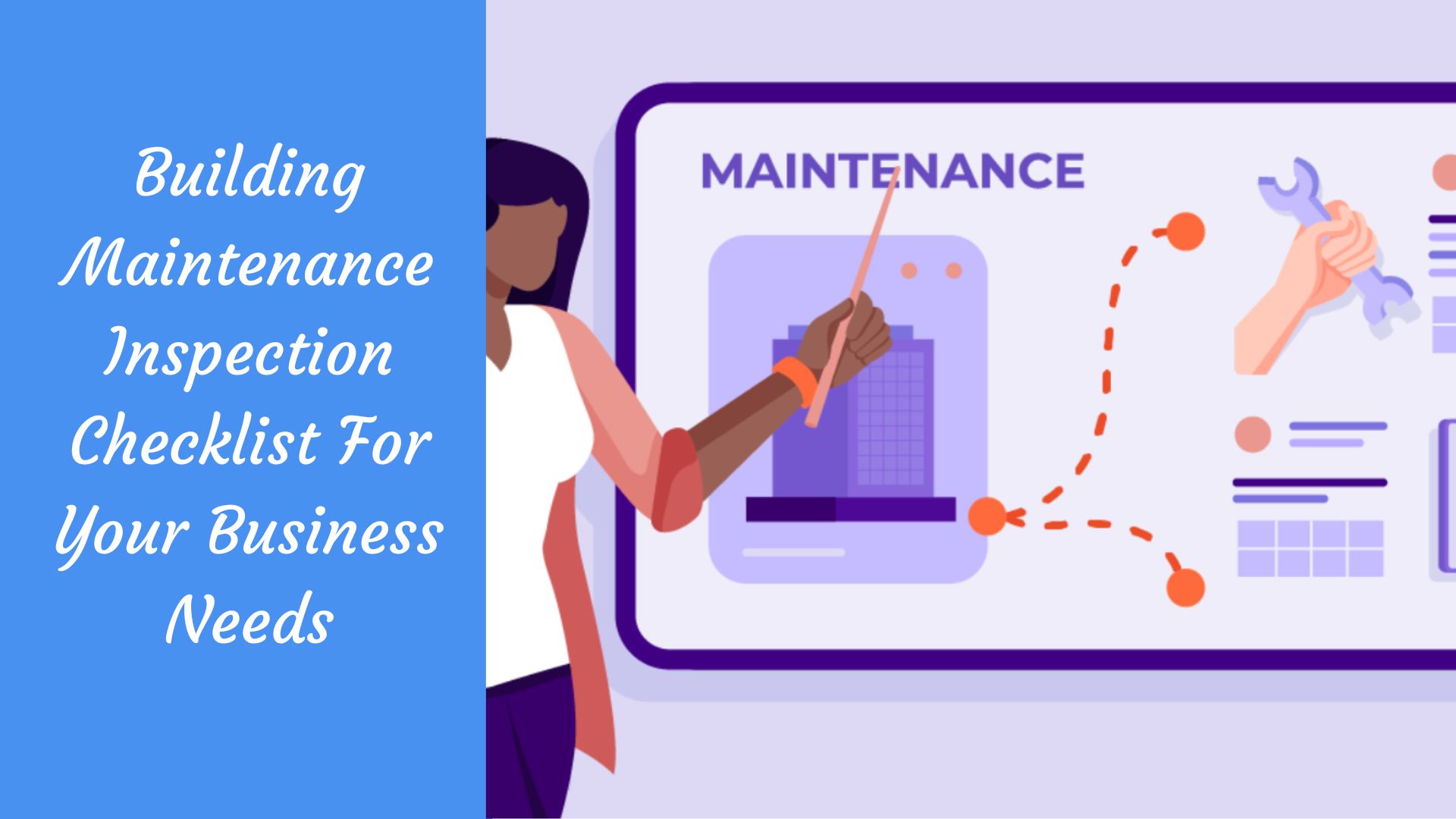
Building Maintenance Inspection Checklist For Your Business Needs
Kirti Prakash |
05 Jun 2024 |
06:42 AM
- What is Maintenance Inspection?
- What is a Maintenance Inspection Checklist?
- Why are Maintenance Inspection Checklists Important?
- Types of Preventive Maintenance Checklists
- Building an Effective Maintenance Checklist
- What Makes A Great Preventative Maintenance Checklist?
- Building Your Maintenance Inspection Checklist with Proptor
- Conclusion

How Plant Maintenance Software Transforms Industrial Operations
Madhurima Sanyal 09 Jun 2024 | 07:17 AMExplore the potential of Plant Maintenance Software, and how it is revolutionizing your industrial facility's efficiency. Discover predictive maintenance, asset tracking, and real-time reporting for a seamless, high-quality operation. ...
Business maintenance made easy! Explore how to Build a Maintenance Inspection Checklist for a seamless approach.
If you're a business owner or manager, you know just how vital it is to keep your premises in tip-top shape. After all, a well-maintained building not only looks good but also runs smoothly, keeping your employees and customers happy.
In this article, we'll look at the essentials of Maintenance Inspection Checklists that are tailored to meet your business needs. We'll cover everything from what should be on your checklist to why it matters and how to put it into action.
What is Maintenance Inspection?
Maintenance inspection is your proactive shield against defects and unplanned breakdowns. Picture it as the health checkup for your assets.
By conducting regular inspections, you gain valuable insights into the condition of your equipment and identify areas for improvement. These inspections encompass a range of activities, from visual examinations to cleaning, replacements, and repairs.
The ultimate goal? To prevent minor issues from snowballing into costly downtime and to enhance both asset performance management and customer satisfaction.
What is a Maintenance Inspection Checklist?
For efficient inspections, there lies the maintenance inspection checklist. It's the technician's trusty tool for documenting inspection activities.
Maintenance checklists are essential for ensuring the continuous operation of your equipment, as they facilitate the systematic checking, repairing, and servicing of critical assets.
These checklists serve as comprehensive records of actions taken and provide a solid foundation for implementing preventive measures to uphold quality and safety standards.
Why are Maintenance Inspection Checklists Important?
Now, you might wonder, "Why do I need a maintenance inspection checklist?" Well, the answer lies in the multitude of benefits they offer:
1. Maintains Reliability: With a checklist in hand, you ensure that your operating equipment remains vailable and in top-notch working condition for the long haul.
2. Ensures Safety: Unforeseen hazards are kept at bay. Machine failures and breakdowns, if left unchecked, can lead to accidents and injuries. A checklist serves as your safety net.
3. Improves Efficiency: Early defect detection is the name of the game. By catching issues before they escalate, you minimize operational downtime, saving both time and money.
4. Provides Good Recordkeeping: Consistently documenting repairs and diagnostics sets the stage for identifying broader trends and supporting future investigations.
Types of Preventive Maintenance Checklists
There are essentially two types of preventive maintenance checklists, and they have been discussed below:
1. A Pass-Or-Fail Preventive Maintenance Checklist
Pass/fail checklists or preventive maintenance program are akin to the vigilant sentinels of your equipment's health. They're designed to detect early signs of trouble, ensuring your machinery operates smoothly. Imagine them as your equipment's personal physicians, checking vital signs and alerting you to any anomalies.
For instance, a pass/fail checklist for a critical machine could direct technicians to inspect the oil level. If the oil level falls within the acceptable range, the equipment passes the examination, signifying all is well. However, if the oil level deviates from the norm, the checklist signals a "fail."
In this case, it prompts maintenance staff to take action – adding more oil to the machine, thus preventing potential damage.
These checklists are invaluable for overseeing the state of vital equipment components, such as temperature, water pressure, or oil levels, on a consistent basis.
A "fail" condition, like an unusual temperature increase, could signify an impending malfunction, prompting immediate investigation and maintenance.
2. A Step-By-Step Preventive Maintenance Checklist
Step-by-step checklists are your trusted guides when it comes to tasks that demand more than simple equipment monitoring.
They excel in procedures requiring the replacement of belts, motors, or other intricate equipment components. Think of them as your recipe book, offering clear instructions to ensure every technician follows the same process and completes all necessary steps.
These checklists provide detailed, sequential guidance on how to execute each facet of the maintenance task. By adhering to a step-by-step checklist, maintenance personnel can guarantee that crucial maintenance procedures are consistently and thoroughly executed.
Imagine a scenario where a motor needs replacement. A step-by-step checklist would outline every action required, from shutting down the machine to safely replacing the motor and conducting post-installation checks.
This meticulous approach ensures that no crucial step is overlooked, minimizing the risk of errors and equipment downtime.
Building an Effective Maintenance Checklist
Maintenance checklists are invaluable tools for ensuring that equipment and assets are properly maintained to prevent unexpected breakdowns and costly repairs. To create an effective maintenance checklist, you need a structured approach. Let's break down the steps:
1. Equipment and Asset Identification
Begin by generating a comprehensive list of all equipment and assets requiring maintenance. This step establishes the scope of your checklist, ensuring that no equipment is overlooked like fire alarm system or hvac systems.
2. Maintenance Task Determination
Identify the specific maintenance tasks for each piece of equipment. This involves referencing manufacturer recommendations, industry standards, and your organization's specific requirements. Each piece of equipment may have unique maintenance needs.
3. Frequency Setting
Determine how often each maintenance task should be performed. Factors to consider include the type of equipment, its age, usage patterns, and environmental conditions. Some tasks may need to be conducted daily, while others could be monthly or annually.
4. Responsibility Assignment
Assign responsibilities for performing each maintenance task. Clearly define who in your organization is responsible for each task to ensure that maintenance activities are consistently completed and on time.
5. Checklist Creation
Develop a clear, concise, and easy-to-follow checklist for each piece of equipment. The checklist should include details about each maintenance task, its recommended frequency, and the individuals or teams responsible for its execution.
6. Checklist Testing
Before finalizing your checklist, it's essential to test it in a real-world setting. Obtain feedback from maintenance personnel who will use the checklist. This feedback can help you refine the checklist, making it more user-friendly and effective.
7. Checklist Implementation
Once the checklist is finalized, integrate it into your building maintenance plan. Provide training to your employees on how to use the checklist effectively. Make sure it's easily accessible to those who need it and who access control systems.
8. Review and Update
Regularly review the checklist to ensure its ongoing effectiveness and accuracy. Maintenance requirements can change over time due to equipment modifications, evolving usage patterns, or other factors. Make necessary updates to keep the checklist relevant.
What Makes A Great Preventative Maintenance Checklist?
Creating an effective preventive maintenance checklist is crucial for ensuring the reliability of your equipment and assets. Here are the key elements of a great checklist:
1. Clarity and Precision - Ensure clear and precise instructions, leaving no room for ambiguity. Technicians should understand each task clearly.
2. Comprehensive Coverage - Generate a comprehensive list of all items that need attention. This sets the checklist's scope, ensuring nothing is missed.
3. Task Specificity - Tailor maintenance tasks to each asset's unique needs based on recommendations, standards, and organizational requirements.
4. Clear Responsibility - Assign responsibilities to individuals or teams for accountability.
5. User-Friendly Design - Design the checklist to be user-friendly with easy-to-follow steps, concise descriptions, and visual aids.
6. Testing and Feedback - Test the checklist in real-world scenarios, obtaining feedback for refinement.
7. Integration and Accessibility - Seamlessly integrate the checklist into your maintenance program for easy access by all involved.
8. Continuous Improvement - Regularly review and update the checklist to adapt to changing maintenance requirements.
Building a great preventive maintenance checklist involves clarity, comprehensiveness, specificity, user-friendliness, and continuous improvement.
Building Your Maintenance Inspection Checklist with Proptor
When it comes to creating a comprehensive and efficient maintenance inspection checklist, Proptor is your go-to solution be it office building maintenance checklist, commercial building maintenance checklist or anything similar.
Proptor is a cutting-edge cloud-based inventory management software designed to streamline your maintenance processes and elevate your facilities management game. The features of Proptor include the following :
1. Track and Manage Inventory
Proptor empowers you to track current stock levels, monitor consumption rates, and replenish inventory as needed.
Say goodbye to the hassles of manual inventory management. With Proptor's automated alerts, you'll never have to worry about running out of essential supplies or materials at any given time and location.
2. Monitor Asset Consumption
Proptor doesn't stop at inventory management; it goes beyond to help you monitor electricity, water, fuel, and other asset consumptions. Keep a close eye on expenses, stock levels, and meter readings with ease. Proptor provides you with the data and insights you need to make informed decisions.
This also helps with equipment failure and equipment maintenance and prevents costly repairs by ensuring proper operation and maintenance activities.
3. Streamline Inspections and Audits
One of Proptor's standout features is its ability to automate inspection and audit processes. Say goodbye to the days of cumbersome paperwork, errors, and inconsistencies.
With Proptor, you can collect standardized data and evidence of work done during inspections and audits, and effortlessly export compliant reports. Make every inspection count with Proptor's intelligent, automated solutions.
4. Enhance Ticketing Workflow
Efficiently manage maintenance issues and requests with Proptor's unified ticketing platform. Minimize costs, boost agent productivity, and elevate customer satisfaction. Collaborate seamlessly with your team members to achieve real-time resolution and keep your tenants and customers satisfied.
5. Choose Proptor for Exceptional Facilities Management
At Proptor, we believe that great facilities management is about more than just maintaining properties. It's about creating exceptional experiences for your tenants and customers.
Maximize employee performance while reducing training costs with Proptor's cloud-based technology, which allows you to deliver content in any format and track employees' progress.
Conclusion
So, if you are planning on building maintenance checklist, of the top notch you should choose Proptor to facilitate you.
With its array of features designed to simplify inventory management, monitor asset consumption, streamline inspections and audits, and enhance ticketing workflows, Proptor stands out as the ultimate solution for facilities management.
Don't settle for ordinary maintenance processes. Choose Proptor and take your maintenance inspection checklist to the next level. Experience the difference Proptor can make in optimizing your facilities management operations.